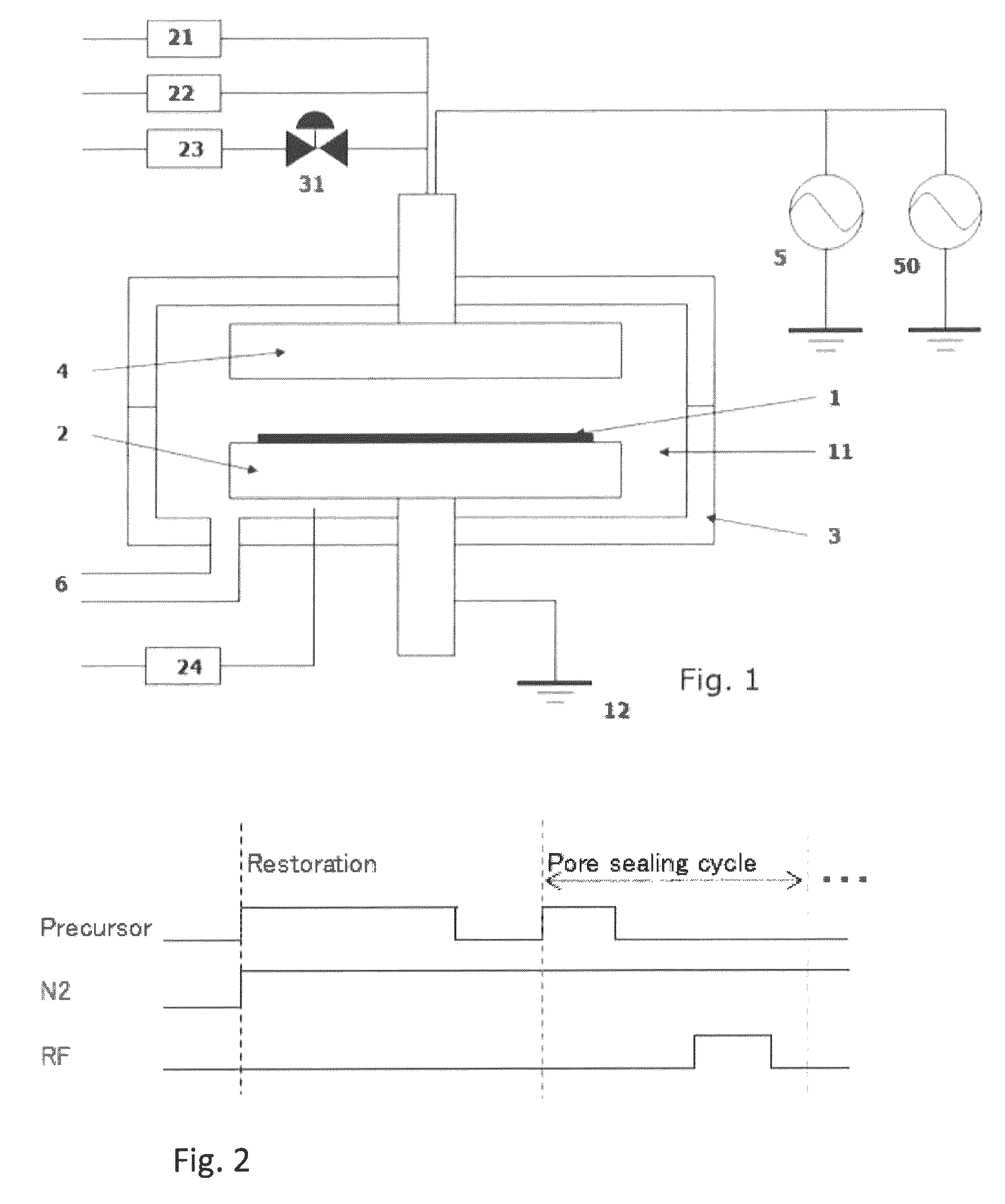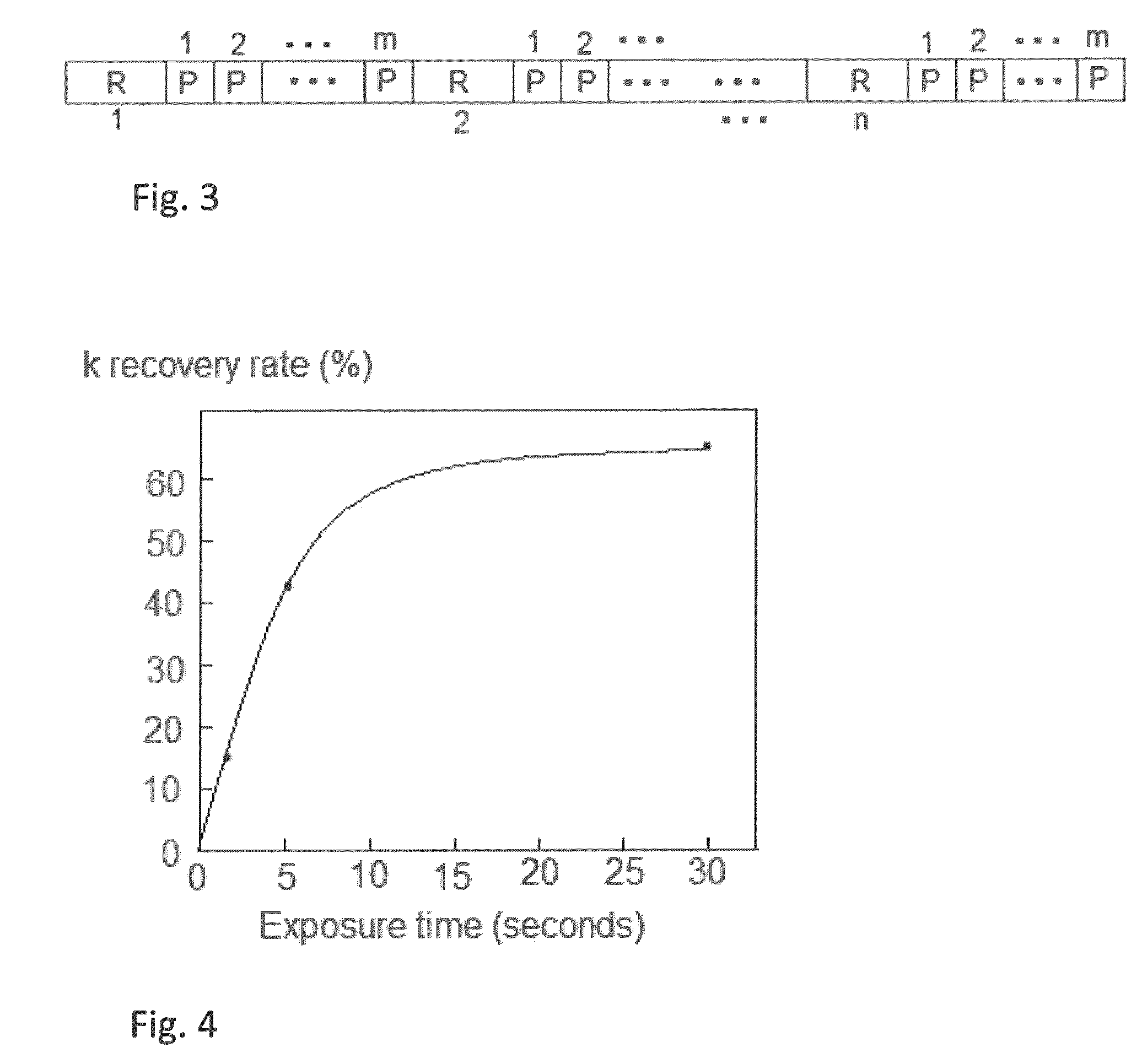Method for repairing damage of dielectric film by cyclic processes
a dielectric film and process technology, applied in the direction of coatings, chemical vapor deposition coatings, metallic material coating processes, etc., can solve the problems of increasing dielectric constants and/or leakage currents, physical damage caused by chemical mechanical planarization (cmp), and increasing dielectric constants.
- Summary
- Abstract
- Description
- Claims
- Application Information
AI Technical Summary
Benefits of technology
Problems solved by technology
Method used
Image
Examples
example 1
[0072]1) A Si substrate (300 mm in diameter) was placed in the reactor and a siloxane polymer film was formed on the substrate using Aurora® X (diethoxymethylsilane; ASM International N.V.) and Pore Builder™ (hydrocarbon for atom transfer radical polymerization; ASM International N.V.), He, and O2. The substrate with the siloxane polymer film was transferred to a UV reactor and subjected to UV cure, thereby obtaining an ELK film having a dielectric constant of 2.00, a porosity of 40%, and a thickness of 200 nm.
[0073]2) Next, the substrate with the ELK film was transferred to a reactor for plasma ashing or etching under the conditions shown in Table 7 below, thereby causing plasma damage to the ELK film. As a result of the plasma damage, the dielectric constant of the ELK film increased to 2.42.
[0074]
TABLE 7Damage conditionRF frequency (MHz)13.56 MHzHRF (W)60 WTreatment time (sec)24 secSubstrate temperature (° C.)250°C.Pressure (Pa)466 PaHe (sccm)2000 sccmO2 (sccm)12 sccmGAP (mm)8 mm...
example 2
[0079]In a manner substantially similar to that in Example 1, a damaged ELK film was prepared, which had a dielectric constant of 2.40. The damaged ELK was subjected to the restoration step and the pore-sealing cycles in the same manner as in Example 1 to obtain a pore-sealed ELK film. Next, the pore-sealed ELK film was loaded into the reactor and exposed to an oxygen plasma (an O2 flow of 12 sccm, RF power of 60 W, a duration of 24 sec, a pressure of 5 Torr, a temperature of 250° C.). The dielectric constant of the plasma-exposed ELK film was 2.40, which was unchanged from that before the oxygen plasma exposure, indicating that the pore-sealing significantly improved resistance to an oxygen plasma, which is indicative of resistance to diffusion of a metal.
examples 3 and 4
[0081]In a manner substantially similar to that in Example 1, an ELK film was prepared and then subjected to plasma damage to obtain a damaged ELK film. The damaged ELK was subjected to the restoration step in the same manner as in Example 1 except for the duration of gas exposure to obtain a surface-restored ELK film. The duration of gas exposure was 1.5 seconds (Example 3) and 5 seconds (Example 4) as compared with 30 seconds (Example 1). The dielectric constant of each film is shown in Table 10 below. As shown in Table 10, when the duration of gas exposure was 5 seconds, the dielectric constant decreased from 2.45 to 2.26, i.e., the recovery rate [(2.45−2.26) / (2.45−2.00)] was 42% (Example 3), and when the duration of gas exposure was 1.5 seconds, the dielectric constant decreased from 2.43 to 2.36, i.e., the recovery rate [(2.43−2.36) / (2.43−2.00)] was 16% (Example 4). In Example 1, when the duration of gas exposure was 30 seconds, the dielectric constant decreased from 2.42 to 2....
PUM
| Property | Measurement | Unit |
|---|---|---|
| thickness | aaaaa | aaaaa |
| dielectric constant | aaaaa | aaaaa |
| temperature | aaaaa | aaaaa |
Abstract
Description
Claims
Application Information
 Login to View More
Login to View More - R&D
- Intellectual Property
- Life Sciences
- Materials
- Tech Scout
- Unparalleled Data Quality
- Higher Quality Content
- 60% Fewer Hallucinations
Browse by: Latest US Patents, China's latest patents, Technical Efficacy Thesaurus, Application Domain, Technology Topic, Popular Technical Reports.
© 2025 PatSnap. All rights reserved.Legal|Privacy policy|Modern Slavery Act Transparency Statement|Sitemap|About US| Contact US: help@patsnap.com



